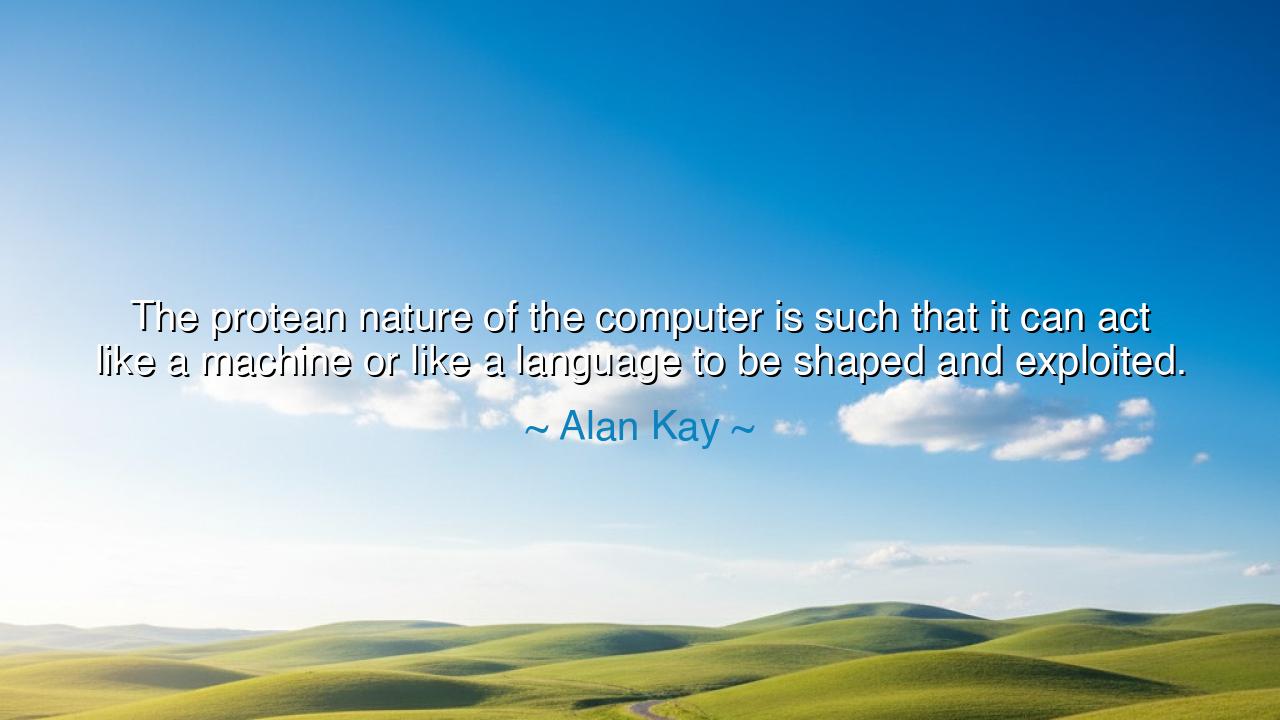
The protean nature of the computer is such that it can act like
The protean nature of the computer is such that it can act like a machine or like a language to be shaped and exploited.






Hear the deep and visionary words of Alan Kay, father of modern computing, who proclaimed: “The protean nature of the computer is such that it can act like a machine or like a language to be shaped and exploited.” This saying is not a technical remark alone, but a revelation of the computer’s true essence. Unlike the hammer, which only hammers, or the wheel, which only rolls, the computer is protean—shifting its form, bending its nature, reflecting the imagination of those who wield it. It is both a tool of labor and a medium of thought, a servant of calculation and a tongue for human creativity.
To call the computer a machine is to see it as one more in the long line of humanity’s instruments. It calculates, it tabulates, it organizes, it performs tasks faster than any scribe or clerk. In this form it appears as pure utility: a device that repeats and refines human labor with precision and speed. Yet Kay, in his wisdom, bids us look deeper. For beyond the machine lies the possibility of the language, the infinite symbols and structures that humans may shape, not merely to automate, but to invent, to imagine, to explore.
Consider the tale of Ada Lovelace, the enchantress of numbers. When others looked upon Charles Babbage’s analytical engine as a machine for arithmetic, she saw something greater. She proclaimed that it might one day compose music, weave art, and express ideas—so long as man could shape the instructions like a language. Thus, in her foresight, she glimpsed the very protean nature of computing that Kay would later describe: that this device is not bound to one function, but is as boundless as the creativity poured into it.
History bears witness to this truth. The same computer that simulates the trajectory of rockets also paints digital canvases. The same machine that calculates the genome also tells stories, creates music, and connects billions of souls across the earth. One moment it is a factory of logic, another it is a stage for poetry. It is both machine and language, not fixed in purpose, but fluid, adaptable, always capable of becoming what imagination demands.
But here lies also the peril: to treat the computer only as a machine is to limit its destiny, to see it as nothing more than a servant of industry. To treat it only as language is to forget its roots in precision and structure. Wisdom requires us to hold both truths together: to honor its power as a tool of work, while also cherishing it as a canvas for creativity. For in this union lies its greatest gift—the possibility of shaping the future, not merely calculating the present.
The lesson is thus: approach the computer not as a passive user, but as a shaper. Do not let it dictate your imagination; rather, let your imagination dictate its form. Learn its languages, explore its depths, and see it not merely as a screen of entertainment or a machine of commerce, but as a vessel for thought, art, and vision. Those who master this duality will not only use computers—they will transform the world with them.
Therefore, beloved seeker, take action. Learn to speak to the computer as you would to a living language. Learn to see it as both hammer and harp, as both forge and flute. Do not be content with consuming what others build; instead, shape it yourself, even in small ways. For in shaping the machine as language, you join the eternal dance of creation.
Thus the voice of Alan Kay resounds like prophecy: “The protean nature of the computer is such that it can act like a machine or like a language to be shaped and exploited.” Remember it, and you will see that the computer is not a cold device, but a living mirror of the human spirit—capable of becoming anything, if only you dare to shape it with wisdom, courage, and imagination.






AAdministratorAdministrator
Welcome, honored guests. Please leave a comment, we will respond soon